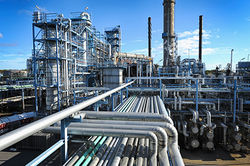Documentation:CHBE Exam Wiki/Module 1 - Process Basics
| CHBE 241 Exam resources wiki | |
|---|---|

| |
| Chemical and Biological Engineering | |
|
Welcome to the CHBE Exam Resources Wiki!
This wiki is intended to host past exams | |
| Past Exams | |
| Final Exam 2016W | |
| Midterm Exam 1 2016W | |
| Midterm Exam 2 2016W | |
| Problem Sets | |
| Module 1 - Process Basics | |
| Module 2 - Reactors | |
| Module 3 - Separations 1 | |
| Module 4 - Separations 2 | |
| Module 5 - Non-reactive Energy Balances | |
| Module 6 - Reactive Energy Balances | |
Question 1
Given a solution that is 20 wt% HCl with a specific gravity of 1.2, find the molarity of the solution.
The molecular weight of HCl is 36.5 g/mol.
Question 2
The molar composition of a gas mixture composed of species A, B and C are 30 mole%, 50 mol% and 20 mol% respectively. The molecular weights of species A, B and C are MA = 12 g/mol, MB = 32 g/mol and MC = 50 g/mol respectively.
Question 2a
Calculate the average molecular weight of the gas mixture
Question 2b
What are the weight fractions of species A, B and C? Using 100 moles as the basis
| Number of moles (mol) | Molecular Weight (g/mol) | Mass (g) | X |
|---|---|---|---|
| 30 | 12 | 360 | 0.1216 |
| 50 | 32 | 1600 | 0.5405 |
| 20 | 50 | 1000 | 0.3378 |
| Total | - | 2960 | 1 |
Question 3
A stream is 70% H2 and 30% N2 by mass. Will the mole fraction of H2 be greater than, equal to or less than 70%? Explain.
Since H2 has a smaller molecular weight, the number of moles and mole fraction of H2 will be larger. Hence, the mole fraction will be larger than 70%.
Question 4
Blueberries contain about 85 wt% water and 15 wt% sugar (solids). To make blueberry jam, blueberries and pure sugar (solids) are mixed at a ratio of 60:40 by mass. Upon mixing, the mixture is then heated until the final water content of the mixture is one-third water by mass.
Question 4a
Draw and label a flowchart of this process.
Question 4b
Perform the degree of freedom analysis
| Parameter | Values |
|---|---|
| Unknowns | 3 (m1, m2, m3) |
| Species balances | 2 |
| Feed ratio | 1 |
| DOF | 0 |
Question 4c
Calculate how many kilograms of blueberries are needed to make a kilogram of jam.
Based on the feed ratio given,
The sugar balance is
By solving both the equations simultaneously,
Question 4d
The cost of sugar and blueberries are $0.15/lb and $2/lb respectively while the cost of operating the evaporator is $85 per day. If the blueberries are fed at 50 kg/hr, what is the cost to produce jam per day? Assume that the production period per day is 10 hours.
Cost of blueberries:
Cost of sugar:
Total cost:









